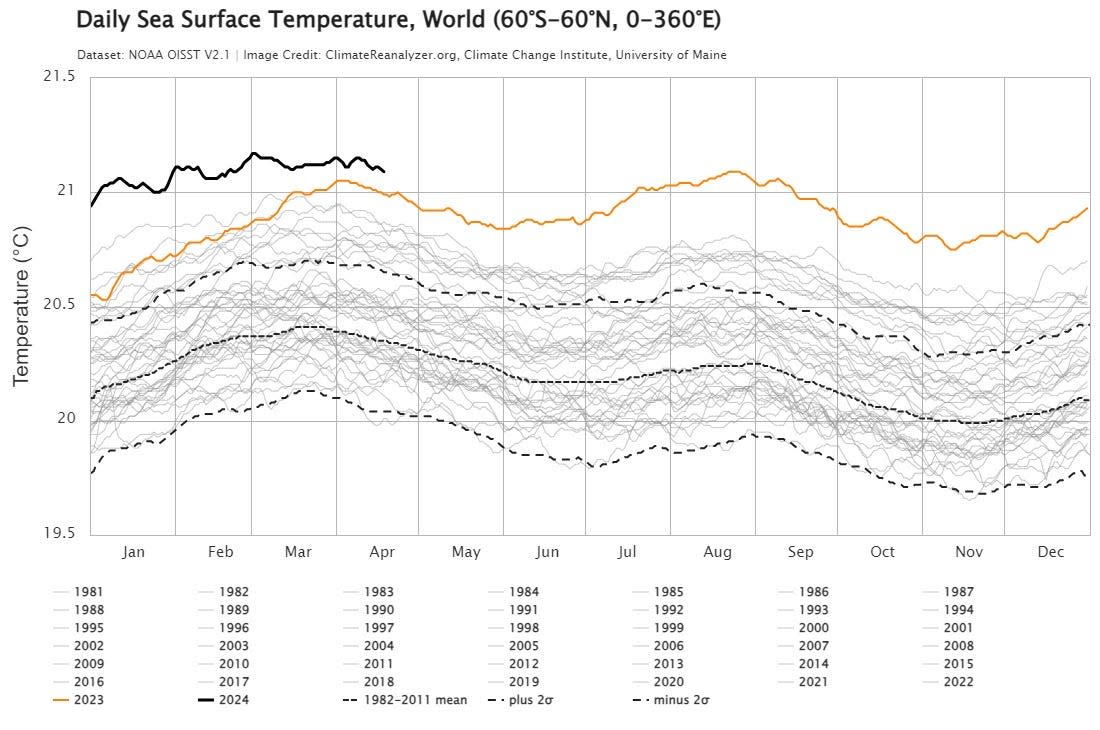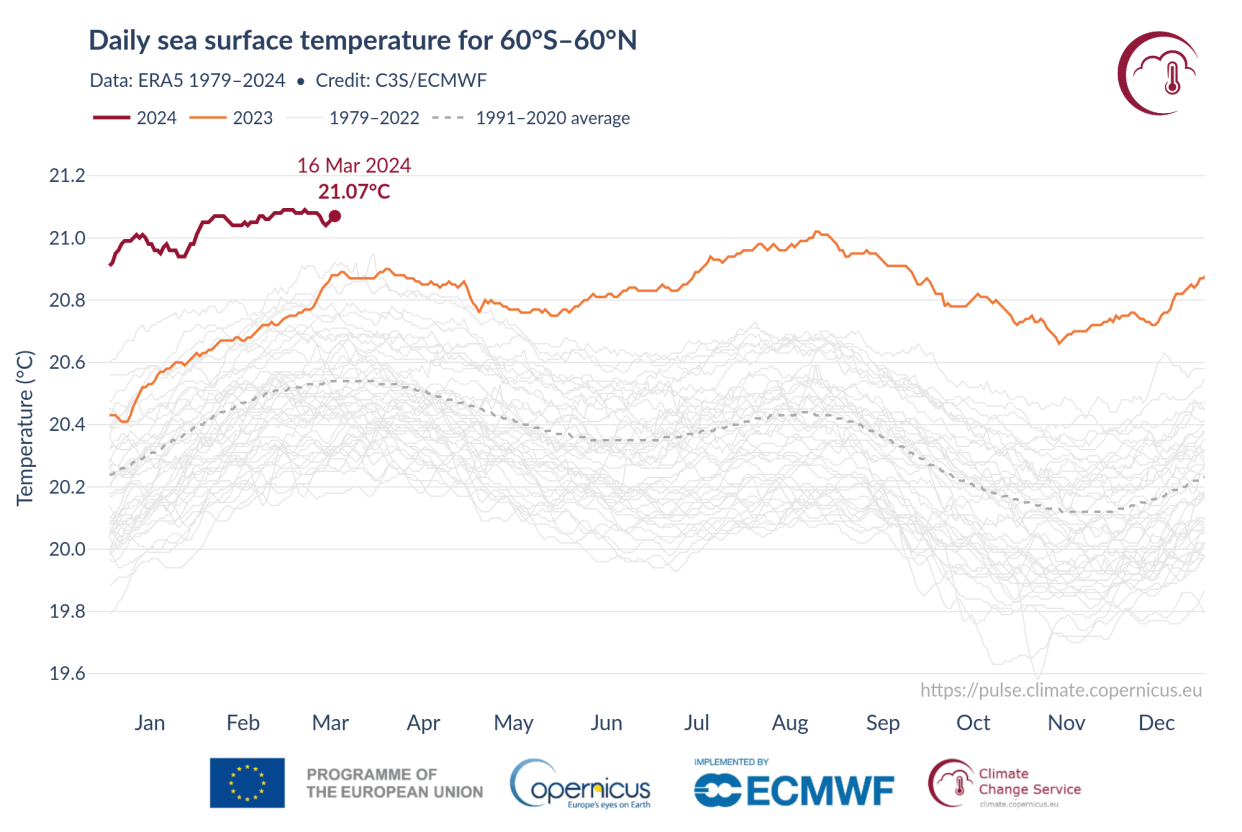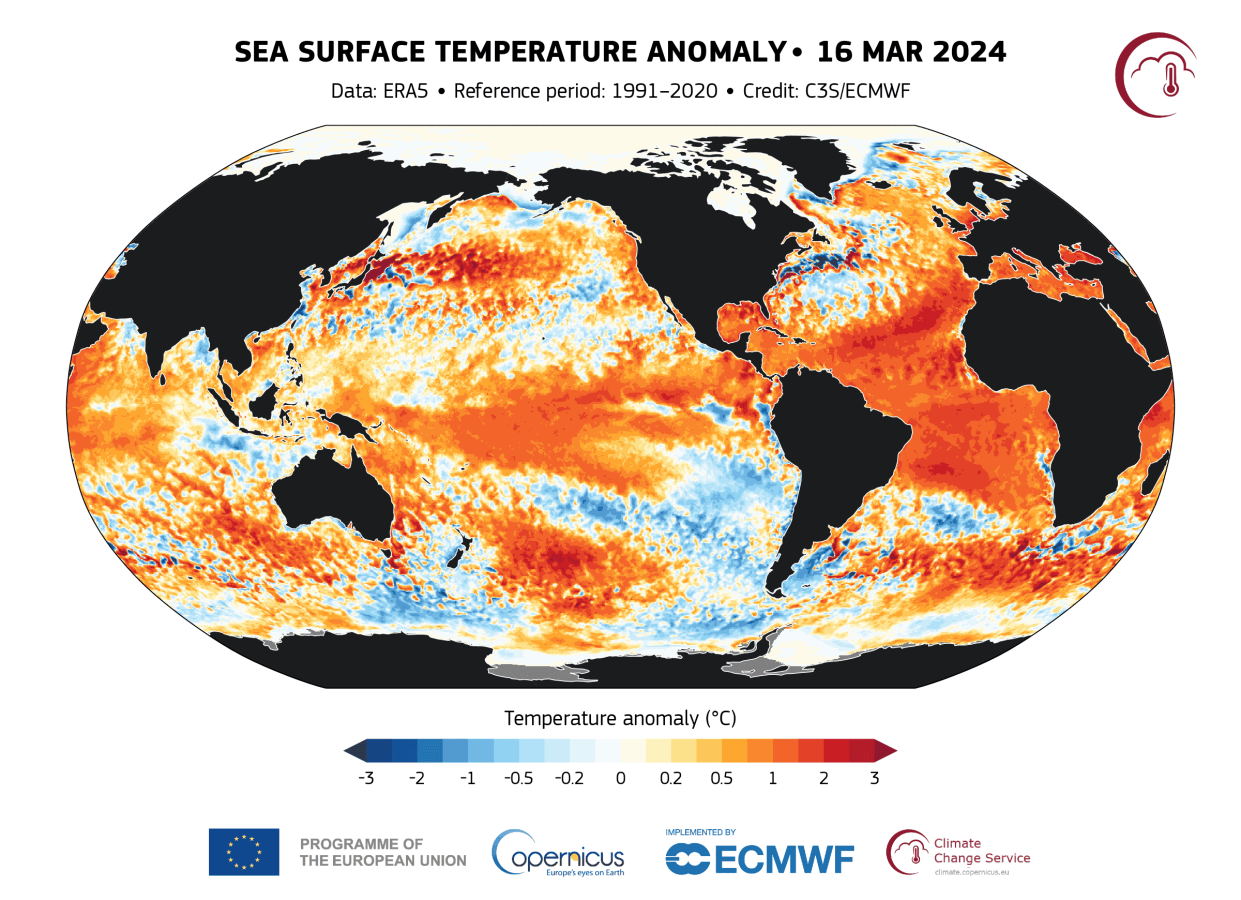Heat records keep puzzling, alarming scientists in 2024. Here's what to know.
Temperatures across the globe hit another monthly record high in March, rising to 2.43 degrees above the 20th century average.
That average is now seemingly a distant memory. The last March where global temperatures were cooler than average was in 1976, when Gerald Ford was president and "All The President’s Men" was raking it in at the box office.
March was the tenth month in a row that global average temperatures were the hottest month on record, says the National Oceanic and Atmospheric Administration. The March average barely edged out the previous record high set in March 2016.
Given the temperatures for the first three months of the year, it’s virtually certain 2024 will be one of the world’s top five warmest years on record globally, NOAA reports. The agency sees a 55% chance the year could be the warmest in the 175-year record.
Across the nation, March was the 17th warmest on record, and no monthly state records were set. However, six states experienced their second warmest average temperatures for the first three months of the year: Maine, Michigan, New Hampshire, New Jersey, New York, Vermont and Wisconsin.
Daily average ocean temperatures around the globe continue to trend higher than previous records. Scientists say that’s increasing the risk of a more active hurricane season in the Atlantic.

NOAA reported on April 15 that a global coral bleaching event has taken place over the past year.
In Australia, the Reef Authority confirmed on April 17 that extreme bleaching – when more than 90% of coral cover on a reef has bleached – has been observed in all three regions of the Great Barrier Reef for the first time. The accumulated heat stress from above average water temperatures has reached the “highest levels to-date,” said the Authority, Australia’s official source for reef monitoring.
Record-breaking start to the year
Nearly three months into the new year, 2024 is carrying on where 2023 ended, with a litany of broken weather records that include higher air temperatures, warmer oceans and higher tides.
That leaves the world's weather organizations and scientists concerned about the degree to which things continue to be so much warmer than normal – and searching for reasons to explain why that is the case.
As the United Nation's World Meteorological Organization released its annual report for 2023 on March 19, Secretary-General Celeste Saulo said it's "sounding the Red Alert to the world."
“Never have we been so close – albeit on a temporary basis at the moment – to the 1.5° C lower limit of the Paris Agreement on climate change," Saulo said.
1.5° C: This number will shape Earth's future as the climate changes. You'll be hearing about it.
Both January and February this year were the warmest on record for the respective months of the year, making nine consecutive months of record warmth, NOAA reported.
In February, the global average temperature was 3.186 degrees above the estimated pre-industrial average, according to the Copernicus Climate Change Service, the European Union's earth observation program.
The global average temperature was also the highest on record for the 12-month period ending in February, Copernicus reported. It was more than 1.2 degrees over the 30-year average for 1991-2020 and 2.8 degrees over the estimated pre-industrial average
Although these global averages are above the 2.7 degrees Fahrenheit threshold set in the Paris Agreement, it's not yet seen as exceeding the goal, because that is based on a long-term, consistent average rather than a measurement from any single month or year.
Still, it's cause for alarm, U.N. officials said in March.
“Sirens are blaring across all major indicators,” said the U.N.'s Secretary-General António Guterres. “Some records aren’t just chart-topping, they’re chart-busting. And changes are speeding-up.”
It’s normal for some weather records to be broken. What isn't so normal is the proportion of them related to warmer temperatures or the degree to which the new records shatter previous records by a long shot.
For example, in Quillayute, Washington in March, a weather station reported a daily record high of 80 degrees, smashing its previous record for the day by 16 degrees, according to the National Weather Service in Seattle.
Record ocean temperatures
Scientists continue to be astonished and alarmed by warmer temperatures across the world’s oceans between the 60 degree latitude lines.
"We're just trucking along," said Andrew Pershing, vice president for science at Climate Central.
"We still don’t quite know exactly what’s driving that and that’s worrisome to just have this big of a signal in the ocean," Pershing said. "We expect the oceans to be warmer but this is really, really significant."
On March 10, the globe’s daily average sea surface temperature briefly jumped to a new record high of 70.16 degrees, according to a chart kept by the Maine Climate Reanalyzer, using NOAA data.
“We’re now at one year and counting of shattering the previous records for ocean heat," said Brian McNoldy, a senior research associate at the Rosenstiel School of Marine, Atmospheric, and Earth Science at the University of Miami. According to model projections, he said, the warmer-than-normal ocean temperatures "look likely" to continue over the next few months in the North Atlantic.

The temperature anomaly is even higher in the region of the Atlantic where most major hurricanes develop. For the first two months of the year, water temperatures in the region averaged nearly 3 degrees above normal over the previous century, blowing past a record previously set in 2010 by a full degree, according to NOAA.
Given a potential La Niña pattern in the Pacific and the warmer ocean temperatures, it doesn't bode well for the Atlantic hurricane season that begins June 1.
Warmest winter on record
What stands out to Pershing about this winter was the scope of the warming in the Upper Midwest. “If you're somebody who grew up around the Great Lakes or you grew up in the kind of icy and snowy conditions in Wisconsin and Minnesota, that just was gone this year, and that's a huge change," he said, both psychologically and economically.
NOAA reported:
The three-month meteorological winter that ended with February was the warmest on record for the globe and the contiguous United States.
Eight states saw their warmest winter on record: Iowa, Michigan, Minnesota, New Hampshire, New York, North Dakota, Vermont and Wisconsin.
Ice coverage across the Great Lakes reached a historic low of 2.7% on Feb. 11.
An additional 26 states saw one of their top 10 warmest winters. Two dozen saw one of their top 10 warmest Februarys.
February made nine consecutive months of record warmth
"February joins the long streak of records of the last few months,” said Copernicus director Carlo Buontempo. “As remarkable as this might appear, it is not really surprising as the continuous warming of the climate system inevitably leads to new temperature extremes."
The lower 48 states saw the third warmest February on record with an average temperature of 41.1 degrees, 7.2 degrees above the 20th century average.
The average temperature in the U.S. in February was 37.6 degrees, 5.4 degrees above average.
Iowa, Minnesota, Missouri and Wisconsin each had their warmest February on record.
Global average ocean temperature for February was 1.8 degrees above last century’s average, almost four-tenths of a degree higher than the previous record temperature anomaly for the month, set in 2016, according to NOAA data.

Record heat is still puzzling scientists
Scientists don't fully understand why temperatures are up so much more than projected.
"It’s humbling, and a bit worrying, to admit that no year has confounded climate scientists’ predictive capabilities more than 2023 has," wrote NASA climate scientist Gavin Schmidt in an opinion piece in the journal Nature.
Atmospheric greenhouse gases are responsible for part of the increase, Schmidt said.
Carbon dioxide levels in the atmosphere continued to increase last year, reaching an annual average of 421.08 parts per million at the Mauna Loa Observatory, according to NOAA data.
In February, the CO2 reading was 424.55 parts per million, up more than four parts per million from last February.
These other factors may be playing a role, but Schmidt said they don't fully explain the surge in temperatures:
El Niño.
Lingering impacts from the eruption of the Hunga Tonga-Hunga Ha'apai volcano in Tonga in January 2022.
Increased solar activity.
Regulations adopted in 2020 that required ships to begin using cleaner fuels in 2020.
Schmidt called for improved and faster data collection to help answer questions.
In general the 2023 temperature anomaly "has come out of the blue, revealing an unprecedented knowledge gap" since satellites began offering comprehensive views of the Earth's climate system, he said. "If the anomaly does not stabilize by August – a reasonable expectation based on previous El Niño events – then the world will be in uncharted territory."
"We need answers for why 2023 turned out to be the warmest year in possibly the past 100,000 years," Schmidt wrote. "And we need them quickly."
NASA's new PACE mission is expected to begin providing data later this year and should be invaluable, he said.
Glacial concerns
After significant losses last year, scientists remain concerned about the world's glaciers and sea ice.
“Climate change is about much more than temperatures. What we witnessed in 2023, especially with the unprecedented ocean warmth, glacier retreat and Antarctic sea ice loss, is cause for particular concern,” said Saulo, the WMO secretary-general.
The WMO reported:
Last year, the global set of glaciers used for reference suffered the largest loss of ice on record since 1950, driven by extreme melt in western North America and Europe.
Western North America suffered record glacier mass loss, at a rate five times higher than rates measured for the period 2000-2019.
Glaciers in western North America have lost an estimated 9% of their 2020 volume over the past four years.
Antarctic sea ice extent was the lowest on record, with an end-of-winter maximum extent at 1 million square kilometers below the previous record.
This article originally appeared on USA TODAY: Heat records broken in 2024: Scientists blame climate change, El Niño
